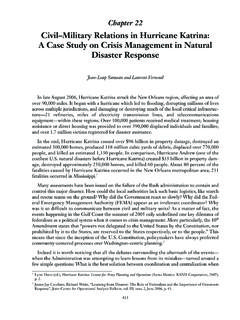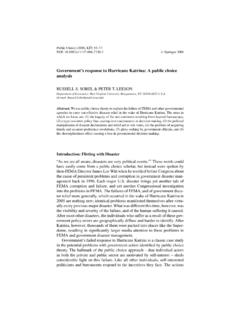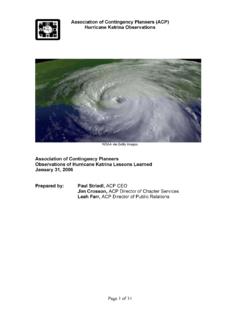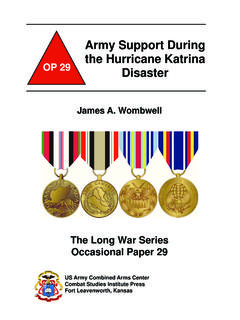Transcription of FEMA Reorganization and the Response to Hurricane ... - ASU
1 fema Reorganization fema Reorganization and the Response to Hurricane Disaster Relief Tonya Adamski, Beth Kline, and Tanya Tyrrell Abstract The authors offer an empirical research study intended to investigate the 2003. restructuring of the Federal Emergency Management Agency ( fema ) under the Department of Homeland Security (DHS). Our study explores the relationship between this restructuring and the efficiency of fema 's Response to Hurricane disaster relief. We hypothesized that Hurricane Response prior to the 2003 Reorganization was managed more efficiently than Hurricane Response following this Reorganization . To investigate this hypothesis, data was collected on 22 hurricanes affecting the mainland and Hawaii from 1988 to 2005. In order to measure the efficiency of Hurricane Response , the following variables were examined: deaths associated with each Hurricane , damage in dollars, the time it took to dispatch fema personnel, and the time it took to dispatch supplies to the affected sites.
2 Since fema directors and presidents can also potentially impact Hurricane management, they were included as independent variables. We also conducted a public opinion survey to offer a better understanding of the public's reaction to fema 's performance in Hurricane relief management, its transition into the DHS, states' reliance on federal assistance, and the impact political affiliation has on these variables. Our findings show that since the 2003 Reorganization , fema has displayed a significant increase in the time taken to dispatch supplies to Hurricane -affected areas. Correlations also were found between the time taken to dispatch supplies and the acting fema director and US President. Survey results showed a significant parallelism between the overall approval of fema and the approval of their management of Hurricane Katrina. Further associations were found between party affiliation and reaction to Hurricane Katrina and states' reliance on the federal government in the event of a disaster.
3 Introduction Throughout its relatively brief history, the Federal Emergency Management Agency ( fema ) has undergone many incarnations. These organizational changes have largely served as a Response to the unique and increasing external challenges confronting the agency, and ultimately, the nation. Perhaps the most encompassing and controversial organizational change experienced by fema was its absorption into the expansive Department of Homeland Security (DHS) in Vol. 3, Spring 2006 3. Tonya Adamski, Beth Kline, and Tanya Tyrrell 2003. Created as a federal Response to the September 11, 2001, terrorist attacks, the large governmental organization of DHS serves as a unified defense structure against the escalating threat of terrorism and other potential hazards (Homeland Security Act, 2002). fema 's assimilation into DHS, which merged more than 22 government agencies, was marked by immense skepticism and controversy. Opponents of this transition feared that revocation of fema 's independent status would severely hamper its ability to quickly respond to disasters.
4 This fear was largely predicated on the notion that additional bureaucratic layers create communication lapses and red tape, forcing officials to abide by tedious rules and regulations. Opponents were concerned that rather than proactively responding to disasters, fema would be subject to these rigid protocols, having to steer through them in order to provide vital services (Glasser & White, 2005). Furthermore, opponents of the transition feared that disaster management would further be jeopardized due to the unintended negative consequences of merging domestic and national security issues. They asserted that, as a result of limited funds and personnel, natural disaster relief would become secondary to security issues under the new, centralized Department of Homeland Security (Glasser & White, 2005). Although not much credence was given to these arguments at the time of the merger, the recent controversy surrounding the management of Hurricane Katrina has refocused attention on these issues.
5 This analysis seeks to empirically examine whether there is, in fact, a relationship between the March 2003 Reorganization of fema into the Department of Homeland Security, and its efficiency in Hurricane relief management. The second segment of this investigation will examine public opinion, gleaned from a survey posted on the World Wide Web, regarding the public's approval of fema . This portion also is concerned with the role that political party affiliation plays in the individual evaluation of fema 's overall performance as well as its management of Hurricane Katrina. Understanding public opinion of fema and the factors contributing to the formation of this perspective is of immense significance. The Federal Emergency Management Agency exists for the very purpose of providing disaster relief and mitigation to the public. Furthermore, it is the public who is directly and irrevocably affected by fema 's efficiency in meeting these goals.
6 Therefore, national opinion is a valid component of the current dialogue and debate surrounding fema 's efficacy in disaster management. The findings yielded through this analysis are of particular importance as fema seeks to redefine its goals and role in a post 9/11 environment. As a result of Hurricane Katrina, national discussion and controversy continues regarding the proper role of fema in disaster management as well as the appropriate structure this vital agency should assume. With congressional hearings pending that seek to answer such critical questions, this study aims to contribute to the body of forthcoming answers. Review of the Literature Early History of Disaster Management 1803-1930s The origins of federal involvement in disaster management can be traced to the early nineteenth century. At this time, local governments were primarily responsible for disaster assistance (Popkin, 1990). Yet when municipal resources were exhausted, officials could call upon state governments for help.
7 Most states, however, were ill-equipped, unprepared, or 4 Perspectives in Public Affairs fema Reorganization unwilling to intervene (Stratton, 1989). Similar problems existed at the national level, where federal assistance was often piecemeal, uncoordinated, or uncertain (May, 1985). No general policies to guide government intervention existed, and it was never clear whether the federal government should or would intervene (Schneider, 1998). The first example of the federal government becoming involved in a local disaster occurred in 1803, when a raging fire destroyed a New Hampshire community. Congress responded by passing a law that provided financial assistance to the town (Haddow & Bullock, 2003). In the century that followed, ad hoc legislation was passed more than 100 times in Response to natural disasters ( fema History, 2005). Under Roosevelt's administration in the 1930s, the federal government began investing in emergency management functions.
8 The Flood Control Act of 1934 gave the Army Corps of Engineers increased authority to design and build flood control projects. In addition, the Reconstruction Finance Corporation and the Bureau of Public Roads were given authority to make financial loans for repair and reconstruction of certain public facilities after disasters (Haddow & Bullock, 2003; fema History, 2005). Evolution of Disaster Management 1950s-1970s Government involvement in natural disasters evolved significantly during the middle decades of the twentieth century (Schneider, 1998). In the 1950s, the federal government began to take a systematic approach to disaster assistance. Over the next two decades, federal programs focused on civil defense against nuclear attacks and long-term recovery from natural disasters (Schneider, 1993). Congress enacted two significant pieces of legislation that made federal assistance readily available to disaster-stricken communities.
9 First, the Civil Defense Act of 1950. delineated the first general, national policy for providing emergency relief, focusing primarily on recovery from nuclear attack. Second, the Disaster Relief Act of 1950 specified a standard process by which state and local authorities could request federal assistance, focusing on long- term recovery assistance such as grants and loans rather than on immediate disaster assistance. Both 1950 laws asserted the federal role in emergency management as secondary to state and local government efforts. Although the 1950s were a relatively quiet time for natural disasters, commencement of the Cold War affected objectives of disaster management. First, nuclear war and nuclear fallout became the principal focus. Second, the idea of disaster preparedness emerged. As a result, state and local governments instituted civil defense programs to prepare for possible nuclear attacks. The directors of these programs became the first recognized face of emergency management in the United States.
10 In the following decade, massive natural disasters required major federal Response and recovery operations. In 1960, the Hebgen Earthquake shook rural Montana, and Hurricane Donna hit west coast Florida. The following year, Hurricane Carla devastated Texas. In an effort to change the piecemeal federal approach to disaster assistance, President Kennedy created the Office of Emergency Preparedness in 1961 to deal with natural disasters. Subsequent calamities tested the activities of the executive preparedness office, including an earthquake, registering on the Richter Scale, which shocked Prince William Sound, Alaska in 1964, and Hurricane Betsy that ravaged the Gulf Coast in 1965. Losses from Hurricane Betsy prompted passage of the National Flood Insurance Act of 1968, amended in 1972, requiring the mandatory purchase of flood insurance for all homeowner loans backed by federal mortgages. This flood legislation Vol. 3, Spring 2006 5.

















